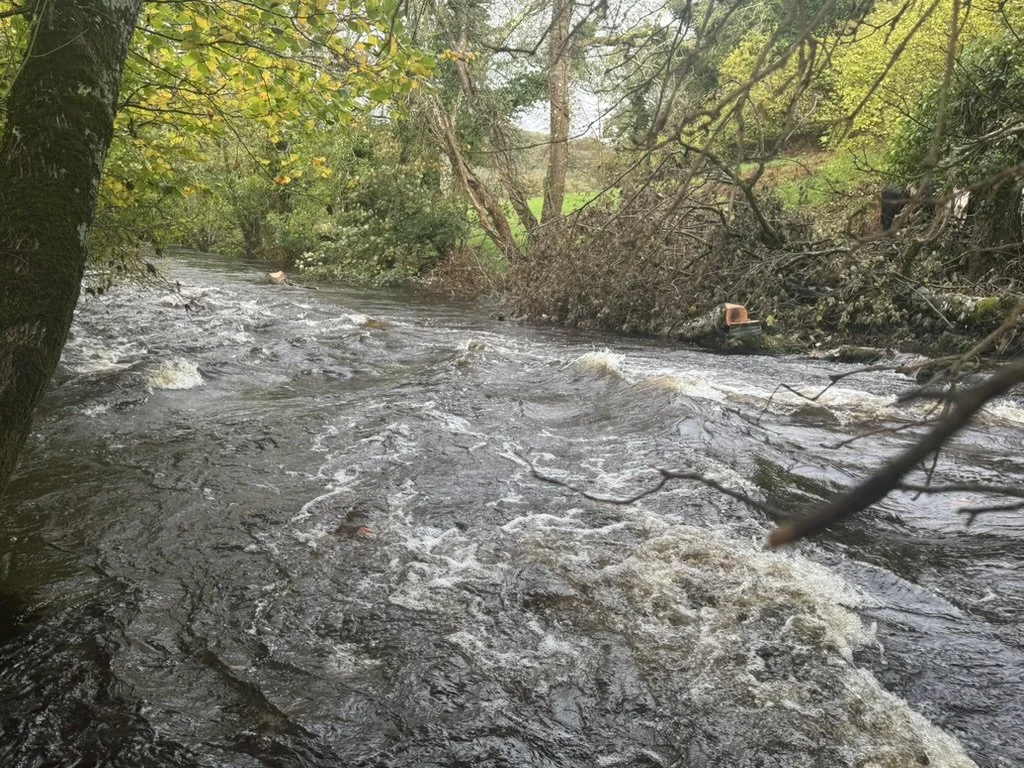Wood, Water & the Way Forward
Why We’re Putting Trees Into the River…
When most people look at any river, they see water, rocks, maybe a fallen tree or two - and the immediate instinct is to go into tidy-up mode: “Surely we should be taking that stuff out?”
It’s a fair question, and for decades, fallen trees were seen as obstructions - hazards to be cleared so water could “flow freely.” But through monitoring and development of best practice, we’ve learned that free isn’t always healthy. In truth, the right bits of wood, placed in the right way, can turn a tired, simplified river channel into a thriving ecosystem once again.
Why We Put Trees in the River
The work captured in this short video shows exactly that - our latest work, with our partners at the National Trust, to introduce large woody debris into a section of the River Teign. It’s simple in principle but powerful in effect.
By placing logs carefully in the channel, we:
Diversify the flow - creating faster runs, slower glides, and calm back eddies where fish can rest or feed.
Form scour pools - deeper hollows downstream of the logs where salmonids can shelter.
Encourage silt and gravel deposition - improving spawning and invertebrate habitat.
Deflect flow away from vulnerable banks - reducing erosion and helping the river hold its shape naturally.
These logs don’t block the river; they guide it. They help it behave more like the dynamic, self-repairing system it’s meant to be
.
What We’ve Done
So just over a month ago, we installed several pinned and tied log deflectors along a stretch of river that had been suffering from erosion and a lack of habitat structure. Alongside that, we planted willow slips along the banks to shore up areas of erosion and provide living reinforcement as they take root.
(Though we can’t help but smile when we spot someone pulling one out to throw as a stick for their dog. We promise, there are better sticks just a few feet away!)
We also restored a washed-away dog watering point that had been pretty much destroyed in last year’s spate. It now gives dogs and owners a safe, designated spot to enter the water - helping to prevent further bank damage elsewhere. Great to see it already being used! It really is ‘build it and they will come!’
How Things Are Settling
It’s early days, but even after just a few weeks, the difference is tangible. The log structures have bedded in beautifully, settling into the riverbed exactly as planned.
Walking the stretch recently, I spotted three good-sized trout holding in the back eddy created by one of the felled and pinned trees - living proof that if you build the right kind of habitat, the fish will find it.
We’re already seeing the first silt deposits forming in the quieter water behind some of the structures - a fantastic sign for next year, when those areas will likely support richer invertebrate life.
We’ve not yet carried out any formal surveys for fish or invertebrates on this section; this will have to wait until next year, but hope is high. The signs are all positive - structure, flow variation, cover - the building blocks of a healthier river.
And despite some recent rainfall, with the river rising nearly a metre, every single piece of pinned and tied woody debris held firm, exactly as intended. That’s a testament to good planning and solid teamwork by all those involved.
Recent additions to the river creating diverse flows during a rise in river level
Seeing the River Differently
For anyone walking the riverbank, this might look unusual - logs in the water, willows sprouting along the edge, sections of bank left deliberately “messy.” But take a closer look and you’ll see the method in the apparent chaos.
These features are shaping flow, catching sediment and gravel, creating pools, and offering refuge to fish and insects alike. In short, they’re helping the river heal itself over time.
Rivers aren’t meant to be manicured; they’re meant to move, shift, and change. By working in harmony with these natural processes - not against them - we give the river back its resilience.
Looking Ahead
Over the next year, we’ll be watching how these structures evolve, how the willows take root, how the sediment builds, and how the fish and wildlife respond. It’s slow work, but it’s the kind of slow that lasts and builds incrementally. This approach is exactly what the Teign and its tributaries need to thrive in the face of hotter summers, heavier floods, and changing conditions.
We’ll share updates as things develop, and eventually, see the survey results to show what difference this intervention has made. But for now, it’s heartening to see signs of life already returning to a stretch that just weeks ago was looking tired and rather featureless.
A good example of woody debris pinching flow to speed up the river in an otherwise featureless stretch
Final Thought
Standing there, watching those trout hold steady in the shelter of new flow, it’s hard not to feel a spark of optimism. The river doesn’t need to be forced - it just needs a gentle nudge, a little help from us to find its balance again.
Sometimes restoration looks like big machinery and heavy work. Other times, it’s simply a few logs, some willow, and a handful of people who care enough to make the effort. That’s the beauty of it: small actions that over time set big things in motion.
If you find yourself walking that stretch, stop for a moment. Watch the way the current curls around a log, the way a pool has deepened, the way new life already moves beneath the surface. That’s the river finding its voice again - and it’s a wonderful thing to see.


